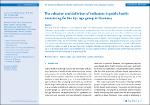The selection and definition of indicators in public health
monitoring for the 65+ age group in Germany
Grube, Maike M.
Scheidt-Nave, Christa
Gaertner, Beate
Lüdtke, Denise
Bosnjak, Michael
Heinrich, Stephanie
Lahmann, Nils
Meyer, Gabriele
Rapp, Kilian
Riedel-Heller, Steffi
Schäufele, Martina
Wolf-Ostermann, Karin
Zank, Susanne
Fuchs, Judith
Selecting relevant indicators is an important step in the development of public health monitoring for older people.
Indicators can be used to combine information comprehensively from various data sources and enable recurring,
comparable findings to be made about the health of older people. Indicators were systematically compiled from existing
international monitoring systems. An indicator set on health in old age was developed using a multistage, structured
consensus-based process together with an interdisciplinary panel of experts. The resulting 18 indicators were assigned
to three health areas: (1) environmental factors, (2) activities and participation, and (3) personal factors. Data sources
that can be used for the indicators are the health surveys within the framework of the Robert Koch Institute’s (RKI) health
monitoring system, as well as surveys from other research institutes and official statistics. In the future, the indicator
set is to be developed further and integrated into an overall approach that is geared towards health reporting and the
monitoring of chronic diseases in all phases of life.
Files in this item

